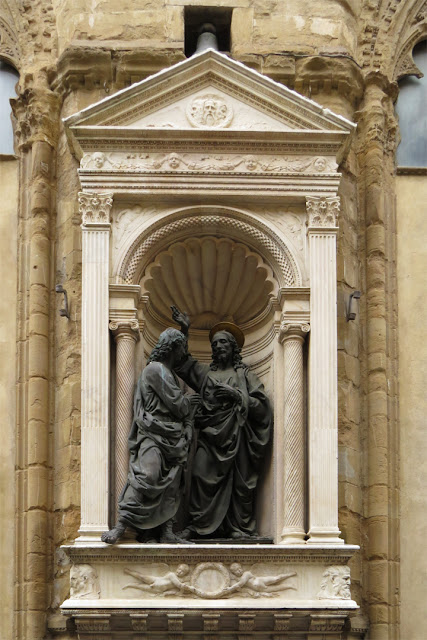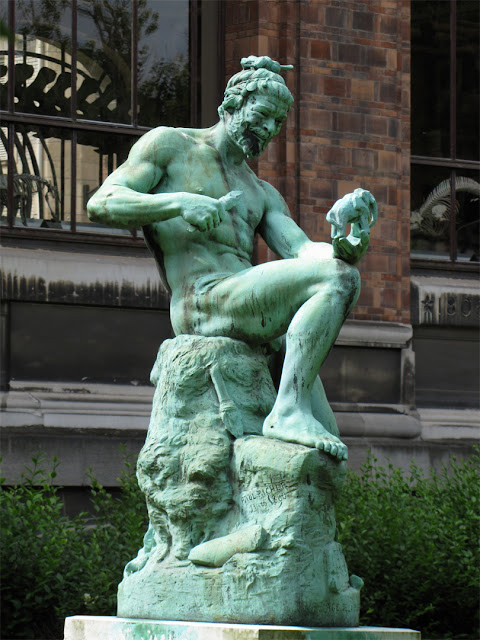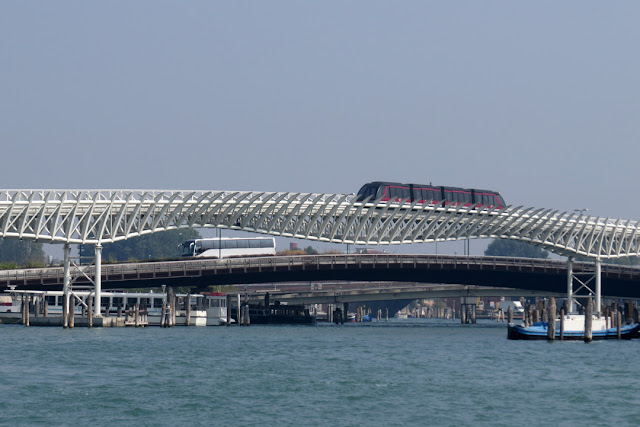Saturday, November 30, 2013
Hans Joachim von Zieten
General der Cavallerie (General of the Cavalry) Hans Joachim von Zieten
Marble original by Johann Gottfried Schadow, 1794
Bronze copy by August Kiss, 1857
Zietenplatz
Berlin, September 2011
“The central section extending to Mauerstraße was called Zietenplatz from 1849 until 1945. The name comes from the statue unveiled in 1794 of the Cavalry General Hans Joachim von Zieten. It formed a unique ensemble of monuments on the square area together with five other statues of generals. Today, the building for representatives of the Province of Thuringia is on the northern corner towards Mauerstraße. The monument of the Hussar General von Zieten was erected again in 2003, followed by the sculpture of the Old Dessauer on 8 June 2005. The newly designed Zietenplatz, based on a design by the landscape architect Reinald Eckert, Berlin was presented to the public in June 2007.” (Zietenplatz and Hausvogteiplatz, Berlin.de)
Friday, November 29, 2013
Raoul Follereau
Raoul Follereau by Dominique Kaeppelin, 1984
Place Raoul-Follereau
Quartier de l'Hôpital-Saint-Louis, 10th arrondissement
Paris, July 2012
L’apôtre des lépreux
(The Apostle of the Lepers)
Personne n'a le droit d'être heureux tout seul
(No one has the right to be happy by themselves)
“In 1936, the director of an Argentine newspaper asked him to go to Sahara region to tread Father de Foucauld's steps, whose 20th anniversary of death was about to be celebrated. It was during one of these travels that Follereau met the leprosy-affected persons for the first time. In the following ten years he traveled the world many times, holding 1200 conferences which allowed him to support the building of Adzopé in Ivory Coast, the town of the leprosy affected persons.” (Raoul Follereau - A Brief Biography, AIFO)
Thursday, November 28, 2013
Michelangelo's David
David by Michelangelo, 1504
Galleria dell'Accademia
Via Ricasoli
Florence, October 2013
“Michelangelo took three years to finish his David. This great work would confirm him as even more than just Florence's greatest sculptor. What the Florentines saw that day in 1504, was a masterpiece with no equal. A giant almost four and a half meters high and the only large nude sculpted after ancient times, as no-one had previously dared to challenge the Greek and Roman masterpieces. But though it does remind us of ancient models, the David sculpture is daringly anti-classical. Its position, though expressing perfect balance, alludes at movement, with its left heal raised off the ground. The attitude is strong, arrogant and, above all, filled with inner life like no other similar classical statue. Behind the apparent equilibrium, his David represses strong energy and tension.” (Michelangelo's David, ItalyGuides.it)
Wednesday, November 27, 2013
I Piombi
The former prison of “I Piombi” (The Leads)
Palazzo Ducale (Doge's Palace)
Venice, September 2013
“The famous Piombi were housed in rooms under the roof. They owe their name to the slabs of lead that covered the roofs, making these rooms extremely hot in summer and ice-cold in winter. These rooms were in general, designated to upper-class inmates or to those awaiting trial. The most famous guest of the Piombi was Giacomo Casanova, who ended up in prison after a long series of crimes and was the protagonist of the most famous and fantastical of escapes: having climbed onto the prison roof, Casanova managed to slide down a drain pipe, slip inside the Palace and then persuade someone to open the door, in order for him to then escape calmly on a gondola. Not, according to legend, without first allowing himself a coffee in the Piazza San Marco.” (Prisons, Doge's Palace, ItalyGuides.it)
Tuesday, November 26, 2013
Monday, November 25, 2013
Interdiction d'accès
No entry sign amended by Clet Abraham
Place du Marché-Saint-Honoré
Quartier de la Place-Vendôme, 1st arrondissement
Paris, July 2012
See also: Clet Abraham - Common Man
External links: Clet Abraham (Livorno Daily Photo)
Sunday, November 24, 2013
Basilica di San Marco
Basilica di San Marco
Piazza San Marco
Florence, October 2013
(On the ceiling: Assunzione della Vergine by Giovanni Antonio Pucci, 1725)
“The church was consecrated in 1443 and became since then on an important hive of activity in the fields of religion, thinking and art which some of its friars were involved in. One of them was Fra Angelico, who began painting at 17 and became a member of the order at 18. He lived in the monastery from 1436 to 1445. The others were St. Antonino da Firenze, Archbishop of Florence, who stayed in the monastery between 1446 and 1459, and then the theologian and thinker Fra Girolamo Savonarola, who became monastic prior in 1491 and, between 1494 and 1498, ruled the Republic of Florence. He died at the stake as the Inquisition Court had believed him guilty of heresy.” (Basilica di San Marco, Divino Villas)
Saturday, November 23, 2013
Do Not Feed the Pigeons
“Non dare da mangiare ai colombi” (Do not feed the pigeons) sign on a bin
“Causano problemi sanitari e danni ai monumenti”
(They cause health problems and damage to the monuments)
Piazzetta di San Marco
Venice, September 2013
“Pigeons attract idiots. Look at this American woman in the Piazza San Marco, Venice. She’s in one of the most beautiful parts of one of the world’s loveliest cities and she’s fascinated by the pigeons. She’s clearly an idiot. She could be looking at the Basilica, she could be looking at the Doge’s Palace, she could be looking at the Procuratie Vecchie but no, she’s looking at pigeons.” (7 Reasons to Hate Pigeons, 7reasons.org)
Friday, November 22, 2013
African Burial Ground
African Burial Ground National Monument by Rodney Léon
Duane Street
New York, September 2008
For all those who were lost
For all those who were stolen
For all those who were left behind
For all those who are not forgotten
“Rodney Léon, 38, a Brooklyn-born architect with the firm Aarris Architects of Manhattan, designed the monument, whose granite slabs rise in acute angles to enclose visitors in the hull-like Ancestral Chamber. An opening in the chamber, straddled by two reflecting pools, leads to a sunken circular court, where voices echo off of walls inscribed with symbols and scriptures. Down a spiraling ramp is the Ancestral Libation Court, the centerpiece. A map of the world, centered on West Africa, is carved into the floor in gray and black granite, along with the archaeological notations made from the 1991 findings. There also is a landscaped garden with seven mounds that mark the burial place of seven wooden crypts containing the remains.” (Nameless Are Memorialized at Old African Burial Site, The New York Times)
Thursday, November 21, 2013
Centre d’études catalanes
“Saint Georges terrassant le dragon” (Saint George slaying the dragon)
By Apel·les Fenosa, 1977
Centre d’études catalanes, Université Paris-Sorbonne
Rue Sainte-Croix-de-la-Bretonnerie, Le Marais
Quartier Saint-Merri, 4th arrondissement
Paris, July 2012
Wednesday, November 20, 2013
Tuesday, November 19, 2013
Vera da pozzo
“Vera da pozzo” (Well-head
Courtyard of Palazzo Cavalli Franchetti
Campo Santo Stefano, San Marco
Venice, September 2013
Monday, November 18, 2013
Rectory of Petrikirche
Former Rectory of Petrikirche (Pfarrhaus der Petri-Gemeinde)
Friedrichsgracht, Spreeinsel
Berlin, September 2011
Sunday, November 17, 2013
Cyrards
Cadets of the Ecole Spéciale Militaire de Saint-Cyr
After the Bastille Day military parade
Boulevard de la Madeleine
Quartier de la Place-Vendôme, 1st arrondissement
Paris, July 2012
“The École Spéciale Militaire de Saint-Cyr (ESM, literally the ‘Special Military School of Saint-Cyr’) is the foremost French military academy. It is often referred to as Saint-Cyr. Its motto is ‘Ils s'instruisent pour vaincre’: literally ‘They study to vanquish’ or ‘Training for victory’. French cadet officers are named ‘saint-cyriens’, or ‘cyrards’. The École spéciale militaire de Saint-Cyr is located in Coëtquidan in Guer, Morbihan department, Brittany, France.” (Ecole Spéciale Militaire de Saint-Cyr, Wikipedia)
Saturday, November 16, 2013
Ponte Vecchio
The Ponte Vecchio (Old Bridge) seen from the Ponte alle Grazie
Above the shops runs the Corridoio Vasariano (Vasari Corridor)
Florence, October 2013
“This charmingly simple bridge was built in 1345 to replace an earlier bridge swept away by flood. Its shops first housed butchers, then grocers, blacksmiths, and other merchants. But in 1593 the Medici grand duke Ferdinand I (1549–1609), whose private corridor linking the Medici palace (Palazzo Pitti) with the Medici offices (the Uffizi) crossed the bridge atop the shops, decided that all this plebeian commerce under his feet was unseemly. So he threw out the butchers and blacksmiths and installed 41 goldsmiths and eight jewelers. The bridge has been devoted solely to these two trades ever since.” (Ponte Vecchio, Fodor's Travel)
Friday, November 15, 2013
Outsized
A “vaporetto” (water bus) sailing along the side of the 333-meter cruise ship “MSC Divina”
Giudecca Canal
Venice, September 2013
“Large cruise ships will be banned from the canal between the mainland and the Giudecca island in the lagoon while a new access channel is developed with the main shipping terminal. The Venice port, which campaigned successfully to preserve the existing passenger terminal, estimates the project will take two years to complete. Over the past 15 years, Venice has become one of the world's most important cruise destinations, with up to nine cruise turnarounds a day in high season. The new measures would limit to five the number of cruise ships berthed at one time, and restrict passage to sunrise and sunset.” (Venice to ban giant cruise ships, The Guardian)
Thursday, November 14, 2013
Oliver Cromwell
Statue of Oliver Cromwell by William “Hamo” Thornycroft, 1899
Parliament Square, Westminster
London, October 2009
“The statue was presented to Parliament by the then Prime Minister, Lord Rosebery, in 1895. It was placed in its current position outside Westminster Hall on 2 November 1899 on the site formerly occupied by the old law courts which previously adjoined the Hall. The statue shows Oliver Cromwell (1599-1658) holding a sword and a Bible, his head bowed in thought. The sculptor, Hamo Thornycroft (1850-1925), is also responsible for the statue of General Gordon which stands on Victoria Embankment.” (Cromwell conservation work, www.parliament.uk)
See also: Charles George Gordon
Wednesday, November 13, 2013
Neuve Saint-Pierre
Terrain d'éducation physique Neuve Saint-Pierre
(Basket, volley, handball and tennis courts, long jump track)
Rue Neuve-Saint-Pierre
Quartier de l'Arsenal, 4th arrondissement
Paris, July 2012
Tuesday, November 12, 2013
Christ and St. Thomas
“Christ and St. Thomas” by Andrea del Verrocchio (copy)
Orsanmichele, Via dei Calzaiuoli side
Florence, October 2013
“Andrea del Verrocchio was more interested than these sculptors were in movement, which he expressed in a somewhat restrained manner. His group of ‘Christ and St. Thomas’ for Or San Michele (c. 1467–83) solves the problem of a crowded niche by placing St. Thomas partly outside the niche and causing him to turn inward toward the figure of Christ.” (Western sculpture, Encyclopædia Britannica)
See also: San Luca - Madonna delle Grazie Altar - San Matteo - Santo Stefano
Monday, November 11, 2013
Antonio Vivaldi
“Le putte di Antonio Vivaldi” by Gianni Aricò, 2006
(Bronze copy of the monument in Rooseveltplatz, Vienna)
Outside San Basilio cruise terminal
Venice, September 2013
Sunday, November 10, 2013
Nathan's Famous
Nathan's Famous, home of the Nathan's Hot Dog Eating Contest
Surf Avenue
Coney Island, Brooklyn
New York, September 2007
See also: Nathan's
Saturday, November 9, 2013
First Artist
“Premier Artiste” (First Artist) by Paul Richer, 1890
Jardin des plantes
Quartier du Jardin-des-Plantes, 5th arrondissement
Paris, July 2012
Friday, November 8, 2013
Common Man
“Common Man” by Clet Abrahams
Ponte alle Grazie
Florence, October 2013
“On January 20, 2011, residents woke to find Clet's Common Man, a life-size fiberglass statue, installed without permission on Ponte alle Grazie. Much appreciated and much photographed, it was removed seven days later. Clet is now trying to find out how to retrieve his sculpture, which was confiscated by the Soprintendenza. His neighbours in San Niccolò have formed a committee and are currently organizing a petition to help him, echoing fans' cries on Clet's 2,000+ strong Facebook page to ‘give us back the Common Man!’” (The man behind the stick figure, The Florentine)
Thursday, November 7, 2013
Venice People Mover
Venice People Mover going towards Tronchetto
Venice, September 2013
“The new public transportation service moves along a 857 metres long circuit which is completely above ground level. Each train will have a maximum capacity of 200 people with an hourly capacity of 3 thousand passengers. The initial estimated budget was €16 billion but due to unexpected works that became necessary during construction, the budget reached € 22 billion.” (People Mover is Working, MyVenice.org)
Wednesday, November 6, 2013
Niemandsland
“Niemandsland” (No Man's Land) by Carmen Leidner
East Side Gallery
Mühlenstraße, Friedrichshain-Kreuzberg
Berlin, September 2011
See also: Berlin Wall - Test the Rest - Bruderkuß - Stay Free - Without Title - Sonic Malade - Vergesst mir die Liebe nicht - Many Small People - Curriculum Vitae
Tuesday, November 5, 2013
Not a Tourist
The lady doesn't look like a tourist...
Quai d'Orsay / Pont Alexandre III
Quartier des Invalides, 7th arrondissement
Paris, July 2012
Monday, November 4, 2013
Great Synagogue of Florence
Tempio Maggiore (Great Synagogue)
Via Luigi Carlo Farini
Florence, October 2013
“The Florence synagogue was built after years of discussion about its location. The community wanted to build it as close to the center as possible, in order to signify what it saw as the important role Jews played in the new, unified Italy which had guaranteed them full civil rights. In the event, the temple was built a little off the old city center. A gift of land and money by congregant David Levi was too good to refuse. Still, the large dome of the Tempio israelitico is a prominent feature of the Florence landscape. The vaguely oriental shape of the dome supplanted an original typicaly neo-renaissance design. This and all the other Moorish features of the temple were virtually imposed on the architects by the professors of the Florentine Academy. ” (Great Synagogue of Florence, Chabad Travel Guide)
Sunday, November 3, 2013
Alison Lapper in Venice
Inflatable version of “Alison Lapper Pregnant” by Marc Quinn
Island of San Giorgio Maggiore, San Marco
Venice, September 2013
“That vulnerability is an inescapable fact of human life, and is what unites each of us to the other. ‘Alison Lapper Pregnant’ strikes me as a heroic image of both truly human vulnerability and strength. Of course, everything I've written above has more to do with the original sculpture of ‘Alison Lapper Pregnant’ than with the inflatable version (12 meters high/39 feet) that now sits beside the church of San Giorgio Maggiore. Does the piece still work as well if the material from which it is made suggests not Michelangelo and Trajan but some huge blow-up Paul Bunyan advertising a lumber yard?” (Marc Quinn's “Alison Lapper Pregnant” on San Giorgio Maggiore, Venezia Blog)
External links: Alison Lapper (Wikipedia)
Island of San Giorgio Maggiore, San Marco
Venice, September 2013
“That vulnerability is an inescapable fact of human life, and is what unites each of us to the other. ‘Alison Lapper Pregnant’ strikes me as a heroic image of both truly human vulnerability and strength. Of course, everything I've written above has more to do with the original sculpture of ‘Alison Lapper Pregnant’ than with the inflatable version (12 meters high/39 feet) that now sits beside the church of San Giorgio Maggiore. Does the piece still work as well if the material from which it is made suggests not Michelangelo and Trajan but some huge blow-up Paul Bunyan advertising a lumber yard?” (Marc Quinn's “Alison Lapper Pregnant” on San Giorgio Maggiore, Venezia Blog)
External links: Alison Lapper (Wikipedia)
Saturday, November 2, 2013
Lady Aileen
The launch “Lady Aileen” of the London Port Health Authority
Seen from the Golden Jubilee Bridge, Hungerford Bridge
London, October 2009
Friday, November 1, 2013
Four Captives
“Four Captives” also known as “Four Defeated Nations”, by Martin Desjardins, 1685
Cour Puget, Musée du Louvre
Rue de Rivoli
Quartier Saint-Germain-l'Auxerrois, 1st arrondissement
Paris, July 2008
“Taken from the pedestal of the statue in the Place des Victoires, these captives represent the nations defeated by the Treaty of Nijmegen (1679). Each expresses a different reaction to captivity: revolt, hope, resignation, or grief. They were first kept in the Invalides (1804-1939) then allocated to the Louvre in 1960 and placed in the grounds of the Château de Sceaux from 1961 to 1992.” (Four Captives, Musée du Louvre)
Subscribe to:
Posts (Atom)






























